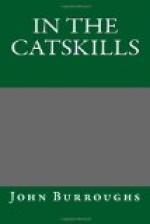Its relative, the phoebe-bird, builds an exquisite nest of moss on the side of some shelving cliff or overhanging rock. The other day, passing by a ledge near the top of a mountain in a singularly desolate locality, my eye rested upon one of these structures, looking precisely as if it grew there, so in keeping was it with the mossy character of the rock, and I have had a growing affection for the bird ever since. The rock seemed to love the nest and to claim it as its own. I said, what a lesson in architecture is here! Here is a house that was built, but with such loving care and such beautiful adaptation of the means to the end, that it looks like a product of nature. The same wise economy is noticeable in the nests of all birds. No bird could paint its house white or red, or add aught for show.
At one point in the grayest, most shaggy part of the woods, I come suddenly upon a brood of screech owls, full grown, sitting together upon a dry, moss-draped limb, but a few feet from the ground. I pause within four or five yards of them and am looking about me, when my eye lights upon these gray, motionless figures. They sit perfectly upright, some with their backs and some with their breasts toward me, but every head turned squarely in my direction. Their eyes are closed to a mere black line; through this crack they are watching me, evidently thinking themselves unobserved. The spectacle is weird and grotesque, and suggests something impish and uncanny. It is a new effect, the night side of the woods by daylight. After observing them a moment I take a single step toward them, when, quick as thought, their eyes fly wide open, their attitude is changed, they bend, some this way, some that, and, instinct with life and motion, stare wildly around them. Another step, and they all take flight but one, which stoops low on the branch, and with the look of a frightened cat regards me for a few seconds over its shoulder. They fly swiftly and softly, and disperse through the trees. I shoot one, which is of a tawny red tint, like that figured by Wilson. It is a singular fact that the plumage of these owls presents two totally distinct phases, which “have no relation to sex, age, or season,” one being an ashen gray, the other a bright rufous.
Coming to a drier and less mossy place in the woods, I am amused with the golden-crowned thrush,—which, however, is no thrush at all, but a warbler. He walks on the ground ahead of me with such an easy, gliding motion, and with such an unconscious, preoccupied air, jerking his head like a hen or a partridge, now hurrying, now slackening his pace, that I pause to observe him. I sit down, he pauses to observe me, and extends his pretty ramblings on all sides, apparently very much engrossed with his own affairs, but never losing sight of me. But few of the birds are walkers, most being hoppers, like the robin.




